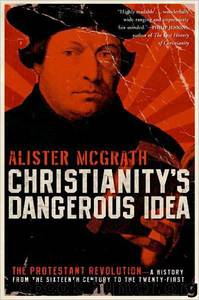Christianity's Dangerous Idea: The Protestant Revolution--A History From the Sixteenth Century to the Twenty-First by Alister McGrath

Author:Alister McGrath
Language: eng
Format: mobi
Tags: Non-Fiction, Religion, Reference, History
ISBN: 9780060822132
Publisher: HarperOne
Published: 2007-09-25T00:00:00+00:00
PROTESTANT VIEWS ON MUSIC IN WORSHIP
Modern Protestant worship makes extensive use of music, especially hymns, choruses, and worship songs. Indeed, Protestants have become so used to singing hymns as part of their worship that many have no idea that this practice was late to develop and was accompanied by much controversy. In this section, we explore how the place of hymns in worship was significantly affected by characteristically Protestant debates about how to understand and apply the Bible.
Luther saw no difficulty with using music in the public worship of the church.29 “Next to the Word of God, music deserves the highest praise,” he wrote. “I do not believe that all the arts should be removed or forbidden on account of the Gospel, as some fanatics suggest. On the contrary, I would gladly see all arts, especially music, in the service of Him Who has given and created them.” Himself a skilled musician, Luther urged others within the reforming movement to write hymns based upon the Psalms in order that the whole of Christendom might be enlightened and inspired.30 Luther’s best-known hymn is a paraphrase of Psalm 46, which opens with the words “God is our refuge and strength, a very present help in trouble.” Luther’s work, set to a tune of his own composing, became a landmark in Christian hymnody: “A Mighty Fortress Is Our God.”31
This work is important in another respect: it represents an example of Luther’s most significant liturgical innovation—the “chorale.” This was a piece of German-language verse written in stanza form, generally set to music similar to popular German secular songs of the period, and sung by the whole congregation during church services. The first such collection appeared in 1524 as the Little Book of Spiritual Songs, which includes “A Mighty Fortress.” Like John Wesley after him, Luther had no difficulty with appropriating well-known songs and changing the words to suit his religious needs. Thus, the popular ballad “I Must Leave You, Innsbrück” became “I Must Leave You, O World.” The chorale tradition was raised to new heights in later Lutheranism by Johann Sebastian Bach.
Whereas Lutheranism developed a rich tradition of vernacular hymns in the sixteenth century—some written by Luther himself—the emerging Anglican and Reformed traditions took the view that God had provided his people with a perfectly adequate set of inspired hymns in the Bible, especially in the Psalms.32 English Protestantism, following the Reformed rather than Lutheran model, dismissed the idea of worship hymns as implying that God’s work was incomplete or inadequate. Worship might therefore include a psalmody, but not a hymnody. Furthermore, early English psalmody was almost exclusively vocal. Most Reformed clergy believed that instruments were appropriate only for secular music, not for public worship. The Psalms were therefore sung without accompaniment—not unlike the plainchant of medieval monasteries.33
Wherever possible, the Church of England directed that the words of the Psalms would be chanted, not paraphrased, despite the metrical difficulties thus created for singing. This nonmetrical approach preserved the integrity of the actual words of
Download
This site does not store any files on its server. We only index and link to content provided by other sites. Please contact the content providers to delete copyright contents if any and email us, we'll remove relevant links or contents immediately.
| Buddhism | Christianity |
| Ethnic & Tribal | General |
| Hinduism | Islam |
| Judaism | New Age, Mythology & Occult |
| Religion, Politics & State |
Cecilia; Or, Memoirs of an Heiress — Volume 1 by Fanny Burney(31348)
Cecilia; Or, Memoirs of an Heiress — Volume 3 by Fanny Burney(30947)
Cecilia; Or, Memoirs of an Heiress — Volume 2 by Fanny Burney(30906)
The Secret History by Donna Tartt(16656)
Sapiens: A Brief History of Humankind by Yuval Noah Harari(13072)
Leonardo da Vinci by Walter Isaacson(11914)
The Radium Girls by Kate Moore(10915)
Sapiens by Yuval Noah Harari(4551)
The Wind in My Hair by Masih Alinejad(4427)
How Democracies Die by Steven Levitsky & Daniel Ziblatt(4410)
Homo Deus: A Brief History of Tomorrow by Yuval Noah Harari(4288)
Endurance: Shackleton's Incredible Voyage by Alfred Lansing(3854)
The Silk Roads by Peter Frankopan(3777)
Man's Search for Meaning by Viktor Frankl(3647)
Millionaire: The Philanderer, Gambler, and Duelist Who Invented Modern Finance by Janet Gleeson(3575)
The Rape of Nanking by Iris Chang(3526)
Hitler in Los Angeles by Steven J. Ross(3446)
The Motorcycle Diaries by Ernesto Che Guevara(3343)
Joan of Arc by Mary Gordon(3268)
